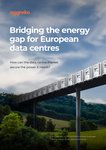The proliferation of new technologies such as artificial intelligence (AI) with its unprecedented data workloads, is driving up data center power usage. In the UK alone consumption is expected to increase six-fold over the next decade.
This, coupled with the general volume increase of data now being produced, and the enhanced storage capabilities required to hold on to this curated and non-curated data, puts sustainability at the heart of data center operations.
How to overcome sustainability hurdles
It’s no secret that data centers require enormous continuous power to run their infrastructure, contributing to substantial emissions. As data demands rise, the energy footprint of data centers is growing, which also leads to higher emissions. However, exactly how to achieve more sustainable operations isn’t always clear.
Data centers must therefore take a more proactive and innovative approach to achieving better sustainability. For example, using tools and technologies to better manage core components of their operations, such as leveraging digital twins – a digital replica of a real-world object or system – to understand airflow changes and better optimize conditions.
Location is also an issue and, as a result, some innovative leaders are already looking to build in close proximity to energy sources such as nuclear power to meet their energy requirements, while lowering emissions. Similarly, companies are building data centers in strategic geographic locations, such as colder climates, to leverage natural cooling for infrastructure, enhancing sustainability and cost efficiency.
Yet, as companies set their net-zero emissions initiatives, it is important that their targets are defined, measured, and executed to ensure they align with established national and international regulations and deadlines. To help data centers overcome their sustainability hurdles, here are six key methods that operators can follow:
More efficient cooling systems
Water and liquid cooling technologies can minimize power consumption and enhance energy efficiency. As previously mentioned, we’re seeing organizations build their data centers in colder climates such as Scandinavia to reduce cooling needs naturally. Direct liquid cooling, which uses liquid channels to draw heat away from specific components, is gaining traction for its precision and efficiency. Liquid immersion is also becoming an option for some customers. This is where servers are either completely or partially immersed in a dielectric fluid to lower their temperature.
Implementing dynamic power management
By adjusting energy consumption based on real-time demand, data centers can significantly enhance their operational efficiency. For example, during periods of low activity, power can be conserved by reducing energy use, thus minimizing waste without compromising performance. This includes dynamic power management technologies in switch and router systems, such as shutting down unused line cards or ports and controlling fan speeds to optimize energy use based on current needs. Conversely, during peak demand, operations can be scaled up to meet increased requirements, ensuring consistent and reliable service levels. Doing so not only reduces unnecessary energy expenditure, but also contributes to sustainability efforts by lowering the environmental impact associated with energy-intensive operations.
Enhancing heat capture and redistribution
Heat generated from data center operations can be captured and repurposed to provide heating for nearby facilities and homes, transforming waste into a valuable resource. This approach promotes a circular energy model, where excess heat is redirected instead of discarded, reducing the environmental impact. Integrating data centers into local energy systems enhances sustainability and offers tangible benefits to surrounding areas and communities whilst addressing broader energy efficiency goals.
Turning to modular and recyclable equipment
To minimize e-waste, equipment should be designed with modularity in mind, enabling easier upgrades and the recycling of materials. Modular components allow for selective replacement or enhancement without needing to discard entire systems. Additionally, extending the lifecycles of equipment further reduces waste by maximizing the use of resources and minimizing the frequency of replacements.
Advanced optical technologies
Optics are a significant contributor to power consumption within data centers. Various initiatives are being developed and implemented to reduce the energy usage of optical modules to address this. Technologies such as Linear Drive Pluggable Optics (LPO), Linear Receive Optics (LRO), and Co-Packaged Optics (CPO) aim to optimize the performance of optical interconnects whilst significantly lowering their energy requirements.
Advancing a net zero economy
By combining the aforementioned elements, data center operators can look to achieve carbon emission reductions and meet science-based net-zero targets. This ongoing and long-term effort, however, will require them to implement energy-efficient technologies, optimize their cooling systems, and ultimately invest in renewable energy sources. These strategic initiatives will help drive industry standards for energy efficiency and carbon reduction, contributing to a more sustainable future.
Existing data center benefits
While there is still work to be done, the truth is that data centers have already played a vital role in advancing sustainability. This can be seen when looking at the technologies they have enabled, especially those that have reduced the environmental footprint of human activity.
One prominent contribution here would be the enabling of virtual collaboration tools like Zoom, Microsoft Teams, Google Meet, and other similar platforms. These solutions have transformed how individuals and organizations communicate, enabling seamless remote interactions. As a result, the need for travel has significantly decreased, leading to reduced carbon emissions from air travel and daily commutes alike.
In addition to supporting virtual communication, innovations in automated network management tools and software-driven approaches have driven sustainability within IT infrastructures. Automated tools powered by machine learning (ML) and artificial intelligence efficiently manage network operations, optimizing energy use by allocating resources only where and when needed. This prevents the over-supply of resources and reduces energy waste.
Software-driven solutions like Software-Defined Networking (SDN) and Network Function Virtualization (NFV) also streamline operations, minimizing physical hardware requirements and enable remote management – which further reduces energy consumption.
Looking to 2025 and beyond, renewable energy sources will likely become a cornerstone of data center operations, transitioning from an ambitious goal to an industry standard. The innovations and practices being adopted—ranging from efficient cooling systems and dynamic power management to heat capture and carbon neutrality—are essential for aligning with global environmental goals.
Therefore, by integrating advanced technologies, adhering to measurable, science-based net-zero commitments, and fostering environmentally focused solutions, data centers are poised to lead the charge in achieving a more sustainable digital future while continuing to support innovation and connectivity worldwide.
Read the orginal article: https://www.datacenterdynamics.com/en/opinions/six-essential-tactics-data-centers-can-follow-to-achieve-more-sustainable-operations/






